
Porridge is a food made by heating or boiling ground, crushed or chopped starchy plants, typically grain, in milk or water. It is often cooked or served with added flavourings such as sugar, honey, fruit, or syrup to make a sweet cereal, or it can be mixed with spices, meat, or vegetables to make a savoury dish. It is usually served hot in a bowl, depending on its consistency. Oat porridge, or oatmeal, is one of the most common types of porridge. Gruel is a thinner version of porridge and congee is a savoury variation of porridge of Asian origin.

Vermicelli is a traditional type of pasta round in section similar to spaghetti. In English-speaking regions it is usually thinner than spaghetti, while in Italy it is thicker.

Semolina is the name given to coarsely milled durum wheat mainly used in making couscous, pasta, and sweet puddings. The term semolina is also used to designate coarse millings of other varieties of wheat, and sometimes other grains as well.

Rice pudding is a dish made from rice mixed with water or milk and commonly other ingredients such as sweeteners, spices, flavourings and sometimes eggs.
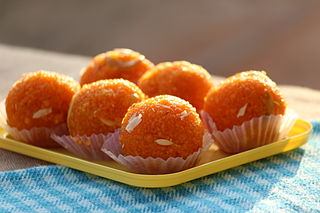
Laddu or laddoo is a spherical sweet from the Indian subcontinent made of various ingredients and sugar syrup or jaggery. It has been described as "perhaps the most universal and ancient of Indian sweets."

Tamil cuisine is a culinary style of Tamil people originating in the southern Indian state of Tamil Nadu and neighboring Sri Lanka. Meats, along with rice, legumes, and lentils, are also popular. Dairy products and tamarind are used to provide sour flavors. On special occasions, traditional Tamil dishes are served in a traditional manner, using banana leaves in place of utensils. After eating, the banana leaves are then used as a secondary food for cattle. A typical breakfast meal consists of idli or dosa with chutney. Lunch includes rice, sambar, curd, kuzhambu, and rasam.

Rajasthani cuisine is the cuisine of the Rajasthan state in North West India. It was influenced by various factors like the warlike lifestyles of its inhabitants, the availability of ingredients in an arid region and by Hindu temple traditions of sampradayas like Pushtimarg and Ramanandi. Food that could last for several days and could be eaten without heating was preferred. Scarcity of water and fresh green vegetables have all had their effect on the cooking. Signature Rajasthani dishes include Dal Baati Churma, Panchratna Dal, Papad ro Saag, Ker Sangri, Gatte ro Saag. It is also known for its snacks like Bikaneri bhujia, Mirchi bada and Kanda kachauri. Other famous dishes include Dal Baati, malaidar special lassi (lassi) and Lashun ki chutney, Mawa lassi from Jodhpur, Alwar ka mawa, Malpauas from Pushkar and rasgulla from Bikaner, "paniya"and "gheriya" from Mewar. Originating for the Marwar region of the state is the concept Marwari Bhojnalaya, or vegetarian restaurants, today found in many parts of India, which offer vegetarian food of the Marwari people. The history also has its effect on the diet as the Rajputs preferred majorly a non-vegetarian diet while the Brahmins, Jains, Bishnois and others preferred a vegetarian diet. So, the state has a myriad of both types of delicacies.
Mithai (sweets) are the confectionery and desserts of the Indian subcontinent. Thousands of dedicated shops in India, Bangladesh, Nepal, Pakistan and Sri Lanka sell nothing but sweets.

Sindhi cuisine refers to the distinct native cuisine of the Sindhi people from Sindh, Pakistan. Sindhi cuisine has been influenced by Central Asian, Iranian, Mughal food traditions. It is mostly a non-vegetarian cuisine, with even Sindhi Hindus widely accepting of meat consumption. The daily food in most Sindhi households consists of wheat-based flat-bread (Mani) or rice accompanied by two dishes, one gravy and one dry with curd, papad or pickle. Freshwater fish and a wide variety of vegetables are usually used in Sindhi cuisine. Restaurants specializing in Sindhi cuisine are rare, although it is found at truck stops in rural areas of Sindh province, and in a few restaurants in urban Sindh.
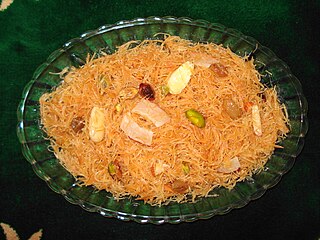
Sevai, shavige, saemia and santhakai is a type of rice vermicelli dish popular in India. While typically made from rice, varieties made out of other food grains like wheat, ragi, and others can also be found.

Sheer khurma or sheer khorma is a festival vermicelli pudding prepared by Muslims on Eid ul-Fitr and Eid al-Adha in India, Pakistan, Afghanistan, and parts of Central Asia. It is equivalent to shemai, a Bangladeshi dessert. It is a traditional Muslim festive breakfast, and a dessert for celebrations. This dish is made from various dry fruits, vermicelli, condensed milk, sugar etc. Depending on the region, cardamom, pistachios, almonds, cloves, saffron, raisins, and rose water are also added.

Ambalappuzha Sree Krishna Swamy Temple is an Indian Hindu temple dedicated to Krishna at Ambalappuzha in Alappuzha district of Kerala. The temple is believed to have been built during 15th century CE by the local ruler Chembakasserry Pooradam Thirunal-Devanarayanan Thampuran. It is one of the seven greatest temples in Travancore. It is considered one among the 108 Abhimana Kshethram of Vaishnavate tradition.
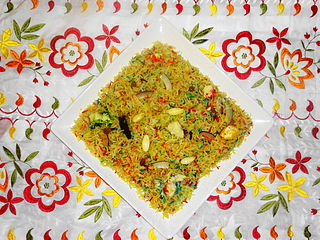
Zarda is a traditional boiled sweet rice dish, native to the Indian subcontinent, made with saffron, milk and sugar, and flavoured with cardamom, raisins, pistachios or almonds. The name 'zarda' comes from Persian word 'zard' زرد meaning 'yellow', because the food coloring added to the rice gives it a yellow color. Zarda is typically served after a meal. In the Indian subcontinent, zarda was and still remains a popular dessert on special occasions such as weddings. It is quite similar to sholezard, a traditional Iranian dessert, and zerde, a traditional Turkish dessert.
Doodhpak is an Indian sweet, a kind of rice pudding made from milk, sugar, rice, saffron and nuts, accompanied by pooris. The milk is slow-boiled to thickened and sweetened and the dish is garnished with chopped dry fruits/nuts. Doodhpak originated in Gujarat.
Kshira is a Sanskrit word for milk. Kshira is also the archaic name for sweet rice pudding, kheer. Kshira is used and perceived differently from normal milk, which is commonly known as Dugdha in Sanskrit. Kshira is variably used for any liquid or watery substance as well. Kshira is also used in Hindu mythology and cosmogony to describe the Ocean of Milk and the abode of the deity Vishnu, the Kshira Sagara.
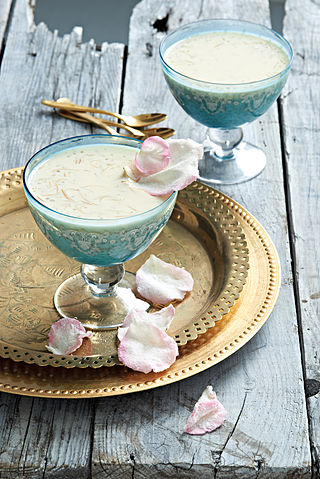
Boeber is the Cape Malay name for a South African pudding. It has become a traditional Cape Malay sweet, milk drink, made with vermicelli, sago, sugar, and flavoured with cardamom, stick cinnamon, and rose water. The pudding is traditionally served on the 15th night of Ramadan to celebrate the middle of the fast, for those who have completed the first 15 days of fasting. They are also known as people who are op die berg.
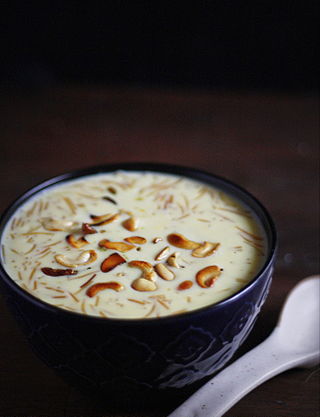
Shemai is a traditional dessert item in Bangladesh and West Bengal, India. Shemai is a popular item during Eid, but it is consumed throughout the year. Shemai is a dessert form of vermicelli, soaked in sweet milk and often garnished with nuts.

Indian Indonesian cuisine is characterized by the mixture of Indian cuisine with local Indonesian-style. This cuisine consists of adaptations of authentic dishes from India, as well as original creations inspired by the diverse food culture of Indonesia. Indian influence can be observed in Indonesia as early as the 4th century. Following the spread of Islam to Indonesia and trading, Muslim Indian as well as Arab influences made their way into Indonesian cuisine. Examples include Indian biryani, murtabak, curry and paratha that influenced Acehnese, Minangkabau, Malay, Palembangese, Betawi and Javanese cuisine.

Ada pradhaman is a traditional Keralan dessert made by using the rice ada with a sauce of cooked coconut milk and jaggery. Ada pradhaman is specially prepared in every home of the state of Kerala,India on the festival day of Onam, it is served together with Sadya. A variety of payasam, ada pradhaman is known as the King of Payasam.

























